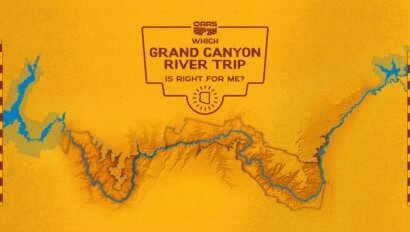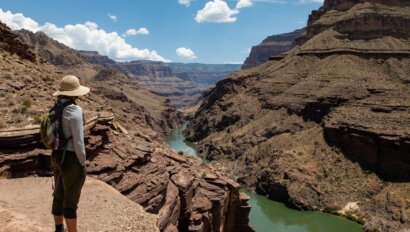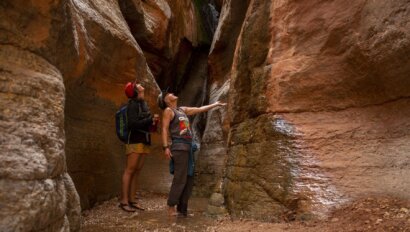Navigating the Uncertain Future of the Colorado River


The Colorado River is facing a water crisis like nothing we’ve ever seen—and here at OARS, we acknowledge the complexity and the weight of this issue. In an attempt to be at the forefront of this challenge for our guests and broader community, we’re launching an investigative series throughout this year that digs deeper into the future of the Colorado and the communities that depend on it—all infused with a healthy dose of optimism. This is the first in that series.
The Colorado River Under Threat
If you’ve read the news recently, it’s impossible to miss the headlines: “Growing fears of ‘dead pool’ on Colorado River” and “Officials fear ‘complete doomsday scenario’ for drought-stricken Colorado River.” Rising temperatures and a megadrought driven by climate change—combined with outdated river management and overallocation of limited water supplies—is threatening the entire region.
Springing from headwaters high in the Rocky Mountains, the Colorado has long quenched the thirst of development, agriculture and power in the West. The Colorado provides water for more than 40 million people, supports a $1.4 trillion economy and irrigates 5 million acres of farm and ranch land. The fates of 30 federally-recognized Tribal Nations, seven states and Mexico hang in the balance. Not to mention the Basin is home to 30 native fish species, two-thirds of which are threatened or endangered, and more than 400 bird species. To say the ripple effects of this mighty river go far beyond basin lines is an understatement.

Outlining their latest projections for Lake Powell and Lake Mead, the nation’s two largest reservoirs, federal water managers warn there is a risk Lake Mead could reach “dead pool” levels as soon as 2025. Dead pool is pretty much how it sounds—when reservoirs reach a level too low to flow through the dam at all. Grand Canyon—connecting the two reservoirs—is at the heart of the issue.
“Grand Canyon is basically stuck between the two largest dams in the United States. There’s been a guaranteed delivery of releases out of Lake Powell to fulfill the law of the river,” Colorado River expert Jack Schmidt says. “I think that we have to recognize that the environment, the ecological and the recreation environment of Grand Canyon has been a completely artificial and novel system that is the way it is because the reservoir has been full.”
Schmidt remembers leading his first research trip in Grand Canyon, “The entire focus of all of us working in late 1980s or mid-1980s was that it was a completely full reservoir system. We didn’t think about the basin as a whole. And now at the end of my career, I mean, it never would’ve ever dawned on me that the reverse is now the case. So in the course of one professional life, we’ve gone from one end of the possibilities to the other. It really is quite remarkable to me.”
For decades, Grand Canyon guides and outfitters have been able to count on at least 8 million acre feet of water flows from Lake Powell to Grand Canyon in a normal year. In 2022, releases from Lake Powell were decreased by 15 percent—from 8.23 million acre feet to 7 million acre feet—and Bureau of Reclamation is now considering even lower releases in 2023.

Schmidt, a professor in the Department of Watershed Sciences and the director of the Center for Colorado River Studies at Utah State University, says the hard truth is that we simply don’t have enough water for everyone. Cities, farmers, power producers and anyone living in the West will feel this shift if they haven’t already, including river runners and outfitters.
In 1936, Hoover Dam created North America’s largest reservoir, Lake Mead. Hoover, downstream of Grand Canyon, generates electricity for Los Angeles, Las Vegas and other major cities, and pumps water to southern California, carrying water to communities and farmers. Glen Canyon Dam, straddling the border of southeast Utah and northeast Arizona upstream of Grand Canyon, was completed in 1963 to create Lake Powell, which according to Bureau of Reclamation, serves “as a ‘bank account’ of water that is drawn on in times of drought. This stored water has made it possible to successfully weather extended dry periods by sustaining the needs of cities, industries, and agriculture throughout the West.” The water flowing through Glen Canyon Dam also produces hydropower, with most of the power going north, south and east, whereas Hoover Dam’s power goes west.
It’s clear that we’ve long overdrafted that bank account with the nation’s two largest reservoirs now standing nearly three-quarters empty, with dwindling levels so significant they can be seen from space.
“Human nature holds on to the desperate hope that maybe this winter it’ll snow, and then it might not be quite such a pressure-filled situation,” Schmidt says. But we’re well beyond the hope that a big dump of snow will fix this problem and with a third-consecutive La Niña winter promising a warmer, drier season, experts are warning that it’s only going to get worse.

So What Now?
John Dillon, Grand Canyon River Outfitters Association (GCROA) executive director, says collaboration is key. Working with the National Park Service and joining other stakeholders in adaptive management discussions, he and the 16 river-running outfitters he works with are also leaning on the stories and knowledge bank of elders in the community and beyond. Indigenous Tribes have lived in Grand Canyon for millenia; John Wesley Powell’s 1869 expedition explored hidden canyons throughout the Colorado Basin, and Bus Hatch led his first trip through Grand Canyon in 1934. The rafting community has been running trips since then—all before the construction of Hoover and Glen Canyon dams.
“Everything we do is inventive and out of evolution. What we know right now is that we do not have enough water to support all the life that depends on this river,” Dillon says. “Every single thing in the Canyon is tied to water, every single one. There’s nothing exempt from the concern of what happens here. And we need to be preparing for that.”
Outfitters and river runners in Grand Canyon may not be the largest stakeholders in the future of Colorado River water. And yes, you’re more likely to find business owners and guides on the oars instead of in a meeting room. But Schmidt says that’s a good thing and he points out that Grand Canyon guides—and the people who join their trips—have a larger role than we might think.
According to a new National Park Service report, more than 4.5 million people visited Grand Canyon National Park in 2021, shelling out $710 million in local gateway communities, supporting more than 9,300 jobs, $324 million in labor income and a $945 million economy. Commercial rafting in Grand Canyon alone fuels a nearly $49 million economy. But that goes beyond the economic influence.

“We should never forget that the Grand Canyon Protection Act in the early ’90s was passed in part because of the hard work of Grand Canyon River guides who would show people Grand Canyon,” Schmidt says. “When you do that, you’ve got a captured audience on your boat of people who are committed and have just had a transforming experience. It’s remarkable how much that motivates people to go back home and do something. The guiding community is going to have an immense potential influence.”
It’s something Schmidt is banking on, and working on with OARS and American Rivers, to bring decision makers, scientists and stakeholders together outside of the meeting rooms and on the river.
“Most of these decisions are made in their comfort zones, meeting in conference rooms and bars, but getting these decision makers out on the rivers they’re actually working on, it forces them to see beyond the numbers and negotiations,” Schmidt says. “There is nothing like getting on the river. People never forget their experiences on the rivers.”
That’s something that hits close to home for OARS. When both Glen Canyon and California’s Stanislaus River were drowned behind dams, it galvanized OARS founder George Wendt’s determination to use his company, as he wrote, “to deliver people into the wilderness and generate excitement for these wild places,” because as he said often, “you save what you love and you love what you know.”
From the beginning, Wendt directed OARS to work with organizations like American Rivers and others to help get decision makers and influencers down the rivers by donating spots on trips and even entire 20-person guided trips. Something his sons and team continues to this day.
And when it comes to navigating the Grand Canyon through this crisis, Schmidt says, “The most adaptable craft to go through Grand Canyon are going to be rowing boats. It’s the job of a guide to ‘make it work.’”

Dillon agrees, “If there’s one thing we can count on, it’s the guides of the Grand Canyon. This has always been an expedition no matter which outfitter you choose, no matter which trip you choose. And I may not know exactly what’s coming or how it’s going to play out, but I can tell you that I would put anybody and anything up against the Grand Canyon guide pool.”
There’s no doubt that we’re facing uncharted territory here, but the fact of the matter remains that the Grand Canyon is a representation of all the majesty that Mother Nature has to offer—and we can use that power to fuel action. “We’ve got to get people out and help them understand that there’s a real river here,” Schmidt says. “What the hell is a river? What does water do ecologically? And what does it mean for recreation?”
Now is the time to get our hands dirty, to let the best guides on the face of the Earth showcase one of the wonders of our planet to the humans who spend their days on this rock because what’s happening in Grand Canyon is more than a headline. Rivers like the Colorado are arteries absolutely essential to the circulatory system of this planet, and we need them to survive. What happens here, now, will write our story. What do you want it to be?
RELATED READING: What Low Water in Lake Powell Means for Cataract Canyon Rafting on the Colorado River
Photos: Colorado River flowing through Grand Canyon – Dylan Silver; Glen Canyon Dam – Sinjin Eberle/American Rivers; Lake Mead water levels in August of 2022 – Dylan Silver; Cracked shoreline at Lake Powell – Sinjin Eberle/American Rivers; Grand Canyon river guide rowing a dory – Dylan Silver; 2022 Colorado River rafting and dory trip through Grand Canyon – Dylan Silver
Related Posts
Sign up for Our Newsletter





